Inclusive Play
8 Keys to Inclusion
Think inclusion is hard? We make it easy for you. By using these 8 keys in your playground design, you’re creating a community asset that invites all people to play, learn, and have fun!

The 'Coolest Thing'
Identify the piece of equipment that children will be the most excited about, and ensure it’s usable for all.

Social Play
Provide play events that stimulate the imagination. Carefully select and place equipment to provide opportunities for solitary, parallel, associative, and cooperative play.

Sensory Play
Incorporate activities that engage the auditory, tactile, proprioceptive, visual, and vestibular sensory systems.

Levels of Challenge
Choose physical play activities that provide graduated levels of challenge, ensuring all ages and abilities are actively engaged on the playground.

Zones
Invite engagement between children of diverse abilities by locating similar types of equipment in the same area. Set the zones so that they’re easily found via an orientation path, which guides people to different areas of play.

Ample Space & Routes
Routes through the play area should be wide enough for people in wheelchairs to pass one another, and to enter, turn, and exit without difficulty.

Surfacing
Protective surfacing forms a unitary shock absorbing surface, which makes it easier for wheelchairs and strollers to enter and navigate the play space.

Fencing
Important to keep children safe so they don’t run or wander out of the play space. A contained play area is especially helpful for those on the autism spectrum.
Resources for Inclusive Playground Design
Download INCLUSIVE GUIDE
A step-by-step guide how to incorporate inclusive play principles into an existing or new playground including design tips.
Download PLAYGROUND 101 GUIDE
Create a poster or attach to email to help boost support for your new playground project in just 10 steps.
See the 8 Keys to Inclusion at
Julia’s Junction in West Kelowna BC

play envy